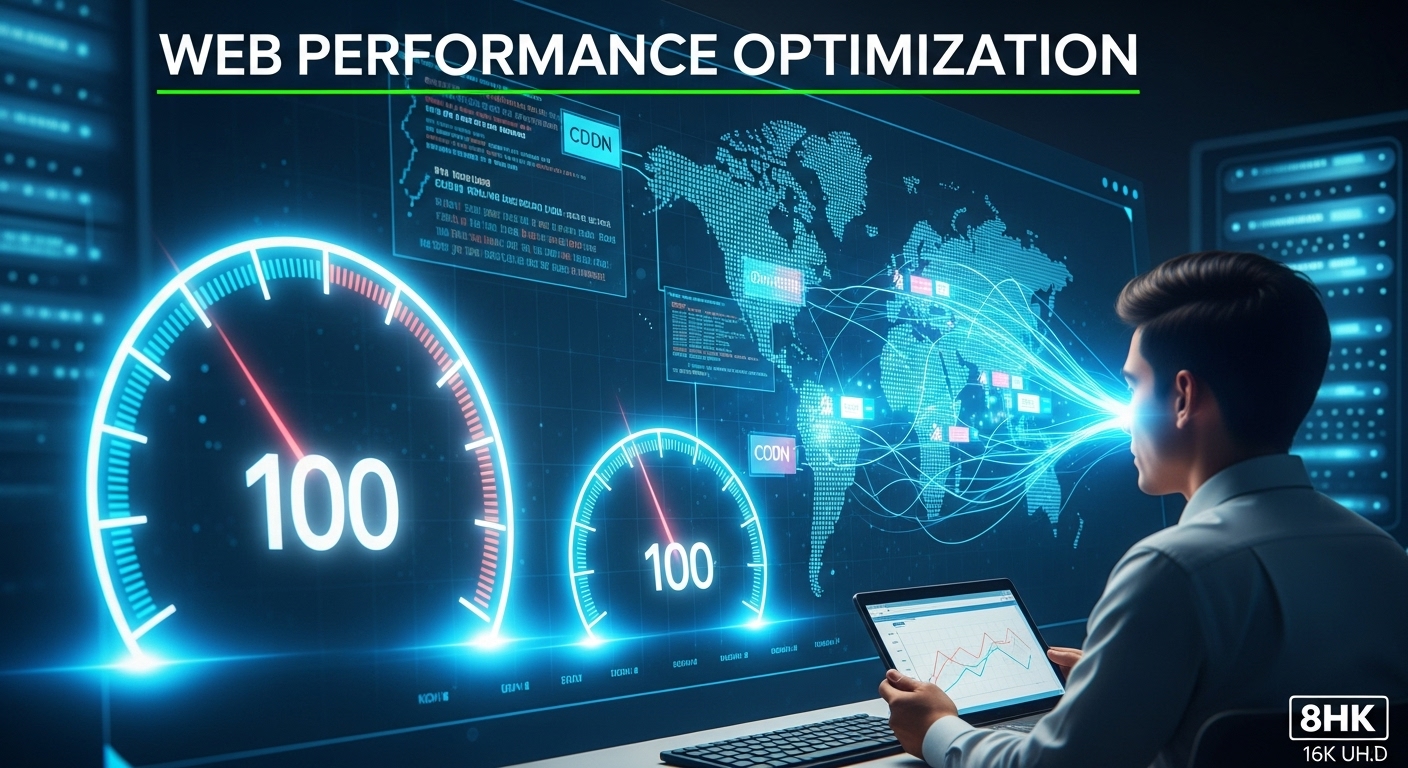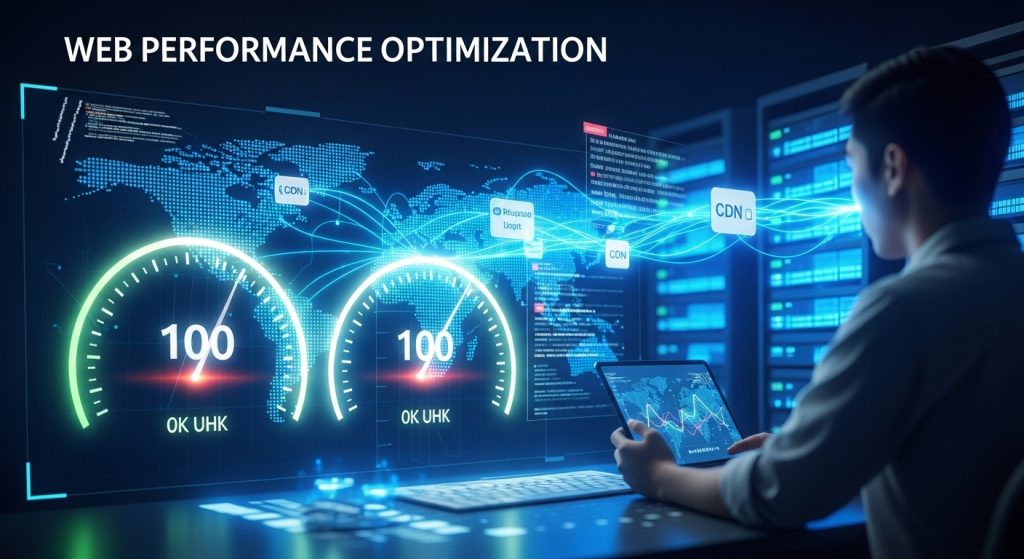
Web Performance Optimization: From 0 to 100 Speed & Edge Strategies
Web Performance Optimization: From 0 to 100 Speed & Edge Strategies
In 2026, speed isn’t just convenience — it’s currency.
Every millisecond between a user’s click and your page load can decide whether you win a customer or lose one to your competitor.
The faster your website, the higher your conversions, the better your SEO rankings, and the longer users stay. But performance optimization isn’t just about compressing images — it’s about designing an ecosystem where servers, networks, code, and browsers work in perfect harmony.
ALSO, READ Programmatic SEO: Scaling Content Without Dilution
This guide from 24SevenHub walks you through Web Performance Optimization (WPO) — the art and science of transforming slow, bloated websites into lightning-fast digital experiences built for Google, users, and growth.

1. What Is Web Performance Optimization?
Web Performance Optimization (WPO) is the process of improving how fast web pages load, render, and interact.
It focuses on reducing latency, eliminating render-blocking resources, and improving Core Web Vitals (CWVs) — metrics Google uses to measure real user experience.
WPO affects:
- SEO rankings – page speed is a confirmed ranking signal.
- User engagement – faster sites reduce bounce rates.
- Revenue – each second saved can increase conversions by 20–30%.
(Akamai, 2025 study)
2. Why Speed Matters More Than Ever
2.1 SEO Impact
Google’s Page Experience update permanently tied ranking potential to Core Web Vitals.
Even perfect backlinks can’t outrank poor user experience.
2.2 UX and Conversions
- 53% of users abandon a site that takes longer than 3 seconds to load (Google Research).
- Amazon found every 100ms of latency cost them 1% in sales.
2.3 Brand Perception
Fast = trustworthy. Slow = outdated.
Visitors subconsciously judge professionalism by how quickly your site responds.
3. Understanding Core Web Vitals
| Metric | Goal | Purpose |
|---|---|---|
| LCP (Largest Contentful Paint) | <2.5 s | Measures load speed |
| FID (First Input Delay) | <100 ms | Measures interactivity |
| CLS (Cumulative Layout Shift) | <0.1 | Measures visual stability |
Use Chrome Lighthouse or PageSpeed Insights to audit these regularly.
4. The 24SevenHub 5-Step Framework for Web Performance Optimization
| Step | Focus | Goal |
|---|---|---|
| 1 | Audit & Benchmark | Identify bottlenecks |
| 2 | Optimize Assets | Reduce file size & requests |
| 3 | Streamline Code | Remove render-blocking elements |
| 4 | Boost Delivery | Use caching, CDNs & edge compute |
| 5 | Monitor & Automate | Maintain long-term performance |
Step 1 – Audit & Benchmark
Use:
- GTmetrix – waterfall analysis
- Google Lighthouse – performance + accessibility
- WebPageTest.org – TTFB & filmstrip view
Record your baseline before changes:
- Page load time
- Time to First Byte (TTFB)
- Requests count
- Page size
Benchmark every major update — optimization is a continuous sport.
Step 2 – Optimize Assets
Images:
- Convert to next-gen formats (WebP, AVIF).
- Use responsive
srcsetimages. - Lazy-load offscreen media.
Fonts:
- Preload critical fonts.
- Use system fonts or variable fonts to cut requests.
Videos:
- Host on optimized CDN or embed via
<iframe loading="lazy">.
Result: up to 40% smaller page size instantly.
Step 3 – Streamline Code
Minify & Bundle
Compress CSS / JS / HTML using Gulp, Webpack, or your CMS’s optimizer.
Defer Non-critical JS<script src="app.js" defer> ensures scripts load after main content.
ALSO, READ Small Business Guide to Cyber Incident Response & Recovery
Critical CSS
Inline only above-the-fold styles, defer the rest.
Remove Render-Blocking Plugins
Audit WordPress or third-party integrations that delay rendering.
Step 4 – Boost Delivery (Caching + Edge + CDN)
4.1 Browser Caching
Set cache-control headers:
Cache-Control: public, max-age=31536000
4.2 Server Caching
- Use LiteSpeed Cache, Redis, or Varnish.
- Cache full HTML responses for anonymous users.
4.3 CDN (Content Delivery Network)
Deliver static assets from servers closest to users (Cloudflare, Bunny, Akamai).
4.4 Edge Computing
Process requests near the user — handle redirects, image resizing, or A/B testing at the edge for sub-second response.
4.5 Compression
Enable Brotli or Gzip; reduces transfer size by ~70%.
Step 5 – Monitor & Automate
Performance degrades over time — plugins, tracking scripts, and updates add weight.
Automation prevents regression.
Set up:
- UptimeRobot for availability alerts.
- SpeedCurve or Calibre for scheduled Lighthouse tests.
- Cloudflare Analytics for global latency insights.
5. Backend Optimization for Developers
- Upgrade to PHP 8.3 + or Node 20 +
- Use persistent database connections
- Optimize queries with indexes
- Enable HTTP/2 or HTTP/3
- Remove unnecessary redirects
Backend tuning often yields the largest TTFB improvements.
6. Hosting & Infrastructure Checklist
| Layer | Optimization |
|---|---|
| Hosting | Use VPS / cloud instead of shared hosting |
| Server | NGINX or LiteSpeed with caching modules |
| DNS | Use premium DNS (Cloudflare / Route 53) |
| SSL/TLS | Enable OCSP stapling + HTTP/3 |
| Monitoring | Automated uptime + error logs |
7. Advanced Front-End Performance
- Use content placeholders (skeleton loaders) to stabilize CLS.
- Prefetch resources with
<link rel="preconnect">. - Inline small SVG icons instead of external files.
- Compress JSON / API responses.
- Use Service Workers for offline caching.
8. The SEO Connection
Google directly links page speed and ranking.
Fast websites:
- Get crawled more often.
- Reduce bounce rate.
- Increase dwell time.
Optimizing performance is optimizing SEO.
9. Real-World Results: 24SevenHub Case Snapshot
Client: TechHaven Consulting (B2B SaaS)
Initial Load Time: 8.9 s → Post-Optimization: 1.7 s
Organic Traffic: +62 % in 4 months
Conversion Rate: 2.3 % → 4.9 %
Actions Taken:
- Implemented Cloudflare CDN + Brotli
- Lazy-loaded media
- Minified JS/CSS
- Deployed edge rules for redirect handling
10. Security & Performance Go Together
Speed without security is fragile.
Use:
- WAF + Bot Protection
- SSL cert renewal automation
- Content Security Policy
- Regular patching
Secure servers deliver stable, fast, and trustworthy experiences — vital for SEO longevity.
11. Tools You Should Be Using (2026 Stack)
Audit: Lighthouse, GTmetrix, SpeedCurve
Optimization: LiteSpeed Cache, WP Rocket, NitroPack
Image: TinyPNG, ShortPixel, ImageOptim
CDN/Edge: Cloudflare, Bunny, Akamai, Fastly
Automation: GitHub Actions, UptimeRobot
12. Future Trends (2026–2030)
- AI-driven performance tuning – predictive caching.
- Edge personalization – instant localized content.
- Serverless SEO – APIs generating ultra-light static pages.
- 5G-level latency reduction – microsecond response.
Tomorrow’s winners will blend speed + stability + security.
13. Key Takeaways
| Lesson | Impact |
|---|---|
| Speed drives SEO and conversions | Better rankings + higher revenue |
| Measure before optimizing | Data-driven improvements |
| Optimize assets & code | Smaller pages, faster render |
| Use caching & CDNs | Global speed consistency |
| Monitor continuously | Prevent slow regression |
14. Conclusion
Every second of delay is a lost opportunity.
Web Performance Optimization turns your site from a heavy brochure into a high-performance business engine.
At 24SevenHub, we don’t just make websites look good — we make them load, rank, and convert at the speed your customers expect.
Speed is no longer a luxury — it’s your advantage.
FAQs
What is Web Performance Optimization?
It’s improving website speed, responsiveness, and user experience through caching, compression, and optimized code
Why does page speed matter for SEO?
Google ranks faster sites higher because they deliver better user experiences.
How can I check my site’s performance?
Use Lighthouse, GTmetrix, or WebPageTest to measure Core Web Vitals.
What’s the best way to improve load times?
Use CDNs, caching, image compression, and optimized hosting.
Can 24SevenHub optimize my website’s performance?
Yes — we specialize in Core Web Vitals improvement, caching, and server-side optimization.




